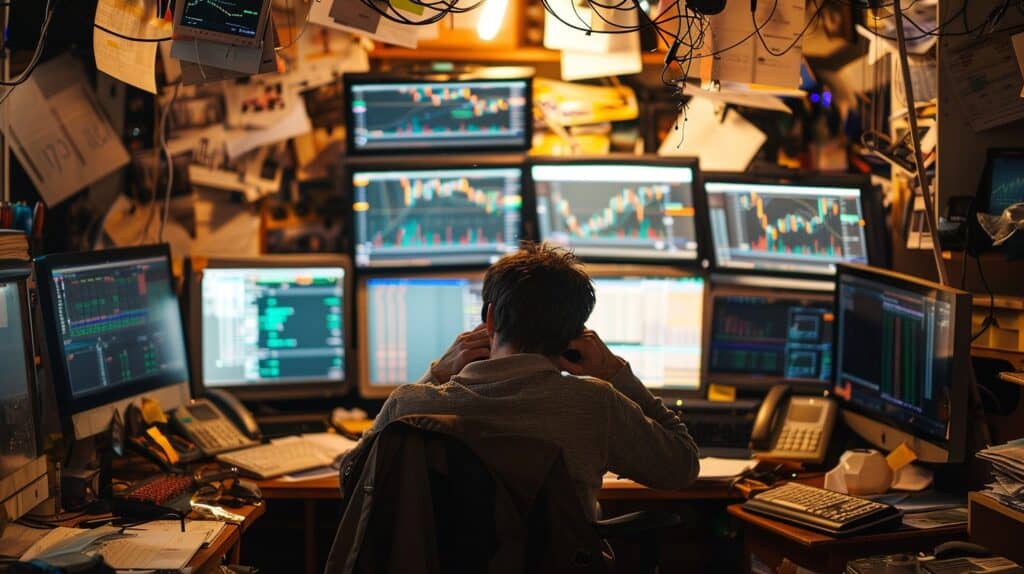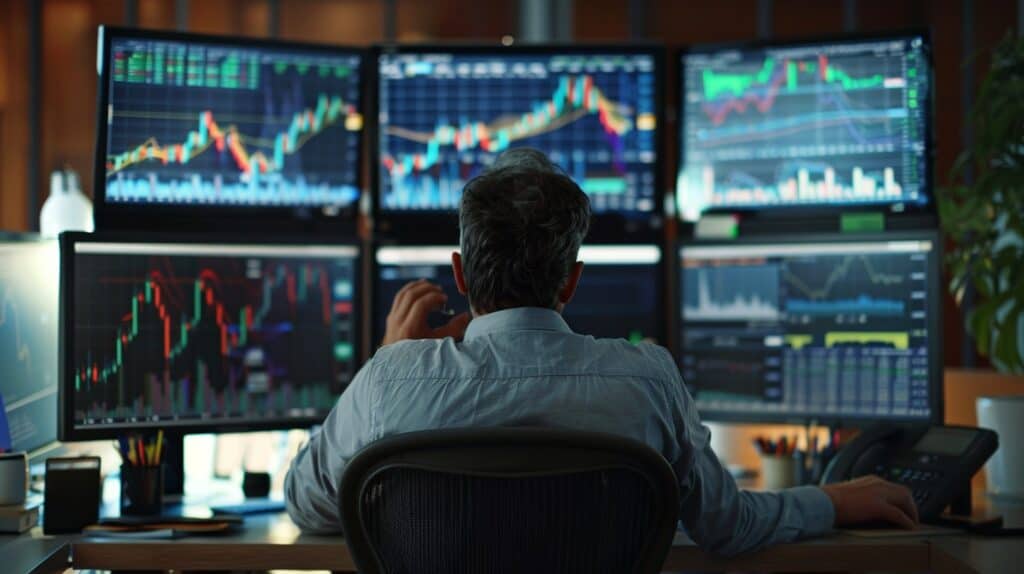You’re there, sitting in front of your screen, wondering why trading often feels like you’re strapped into a never-ending rollercoaster. It’s a familiar scene for many, caught in the relentless ebb and flow of market highs and lows.
Surprisingly, over 90 percent of traders wind up throwing in the towel because cracking the code on their trading psyche seems like an insurmountable task. However, here’s a bit of optimism to brighten your day: this article is about to dive deep into how mastering the intricacies of trading psychology can morph those setbacks into solid stepping stones.
Eager to shift perspectives? Stay tuned!
Key Takeaways
Trading psychology involves managing your emotions and biases to make better trading decisions. Understanding how fear, greed, and overconfidence affect you can help avoid common traps like holding on to losing stocks too long or selling winners too soon.
Strategies to overcome trading biases include staying educated on market trends, seeking diverse viewpoints to challenge your own, setting stop-loss orders to limit losses, journaling trades to reflect on decisions, and practicing mindfulness to stay focused.
The role of behavioral finance in trading psychology highlights the importance of understanding why we make certain financial decisions, influenced by psychological factors. This knowledge helps navigate the volatile market more effectively.
Successful traders share traits such as not getting paralyzed by analyzing too much data (analysis paralysis), accepting market volatility as part of trading, regularly reviewing their performance through things like equity curves, ignoring irrelevant market noise for clearer decision-making, implementing effective risk management strategies including knowing when to exit a trade for both profits and losses, and engaging in self-reflection to understand their own behavioral patterns in trading.
Table of Contents
Understanding Trading Psychology: Definition and Importance

Alright, let’s crack into what trading psychology is and why it’s the big cheese in the game of financial markets. Picture your mind as a battlefield where logic tussles with emotions like fear, greed, and overconfidence.
This mental tug-of-war affects how you make decisions about buying or selling stocks, when to hold ’em tight, and knowing the best time to trade. It’s that inner voice telling you not to put all your eggs in one basket or getting cold feet just before making a significant move.
Grasping this concept matters because it shines a spotlight on common traps we fall into, such as letting losses run too deep or cutting winners short – classic emotional bias moves.
By understanding our own psychological makeup, we can learn to dance in rhythm with market volatility rather than getting trampled by it. And here’s the kicker – mastering trading psychology isn’t just about keeping your emotions in check; it’s also leveraging them to make disciplined and rational decisions under pressure.
So yes, those gut feelings have their place at the table, but need to be served alongside a hefty portion of risk management strategies and self-reflection for dessert.
Identifying Key Behavioral Biases in Trading

Spotting your own biases in trading is like trying to notice you’ve got spinach in your teeth without a mirror. It’s sneaky but game-changing once you see it.
Cognitive Biases
Let’s dive headfirst into the world of cognitive biases. These sneaky little critters mess with our trading decisions more than we’d like to admit.
- Confirmation Bias – This one’s a classic. I catch myself looking for information that agrees with my pre-existing beliefs and ignoring everything else. It’s like going fishing and only keeping the fish that tell me I’m awesome.
- Overconfidence Bias – Ah, the old “I’m the king of the world” feeling after a few successful trades. It makes me feel invincible, leading to riskier bets because, obviously, I can’t lose (until I do).
- Anchoring Bias – Ever clung to a specific number like it was my childhood teddy bear? That’s anchoring bias for you. Whether it’s the price I paid for a stock or an expert opinion, once it’s in my head, it skews all future decisions related to that number.
- Hindsight Bias – Oh boy, this one makes me believe I knew it all along after something happens in the market. “I totally saw that crash coming,” except, nope – didn’t have a clue.
- Loss Aversion – The pain of losing $100 feels way sharper than the joy of winning $100. This fear of losing money can paralyze my decision-making or push me into making hasty moves to ‘stop the bleeding’.
- Herding Behavior – Just because everyone is buying Bitcoin doesn’t mean I should too. But sometimes, seeing a herd move in one direction tempts me to follow without doing my own research.
- Availability Bias – Recent events or dramatic news tend to play tricks on my mind, making me overestimate their importance or likelihood of happening again.
- Status Quo Bias – Change scares me sometimes; sticking with what’s familiar feels comforting, even if it’s not serving my best interests anymore.
- Mental Accounting – Dividing money into different ‘accounts’ in my head leads to irrational decisions, like taking higher risks with ‘house money.’
- Illusion of Control – Flipping charts and tweaking strategies give me a sense of control over market movements which, frankly, are beyond anyone’s control.
Emotional Biases
Alright, fellas, I’ll dive right into the thick of it – tackling emotional biases in trading is not for the faint-hearted. It’s all about wrestling those sneaky feelings that sway our decisions far from rational shores. So, grab your mental surfboard, and let’s ride the waves of our own psyche.
- Fear of missing out (FOMO) – This one hits hard, especially when you see a stock skyrocketing and everyone seems to be cashing in except you. It’s like being the last one picked for dodgeball. FOMO can push you to jump into trades without proper analysis, risking a belly flop into financial disappointment.
- Greed or the “just a little more” syndrome – Picture this: You’re winning, and instead of pocketing those gains, something whispers in your ear, “Wait for it… wait for it…” And bam! The market does a 180, leaving your profits in the dust. Greed blinds us to stop-loss strategies and proper risk management.
- Overconfidence after a win streak – Scoring big on a few trades can make you feel invincible, as if you’ve cracked some secret market code. Unfortunately, this superhero feeling often leads to taking unnecessary risks because your judgment gets clouded by an illusion of infallibility.
- Regret from past mistakes – Ever made a trade that didn’t pan out so well? Who hasn’t? But dwelling on these losses can paralyze decision-making and deter you from taking calculated risks in the future.
- Attachment bias – Sometimes we fall in love with certain stocks or sectors because they’ve been good to us before or come with sentimental value (like your first beer money investment). However, staying loyal to underperformers based on emotion is like refusing to throw out your favorite sneakers even though they’re falling apart.
- Herd behavior kicks in when everyone zigs, and you feel compelled to zag just because it seems like the safe bet at the moment. But remember, guys, just because everyone jumps off a bridge doesn’t mean we should follow suit without checking where we’ll land.
The Impact of Neglecting Trading Psychology

Ignoring trading psychology is like trying to drive a car without wheels. You just won’t get far. Let’s face it, our brains can be our own worst enemies at the trading desk. Emotions such as fear and greed start playing the puppet master, making us dance to tunes that can lead out of rhythm with the market’s beat.
The result? Poor decision-making and, more often than not, a portfolio that looks like it went through a shredder.
Pitfalls are everywhere when you leave your mental state unchecked. Imagine impulsively jumping on every stock tip from your buddy at the gym or getting swayed by the daily news cycle’s doom and gloom.
Before you know it, you’re overtrading or frozen in fear from taking any action—classic signs of emotional abuse towards your investment strategy caused by neglecting behavioral finance principles.
It’s not about being cold-hearted; it’s about keeping those emotions in check so they don’t cloud your logic or lead you down a path of regrettable decisions fueled by momentary impulses or herd behavior mimicry.
Strategies to Overcome Trading Biases

To dodge those pesky trading biases, we’ve got some slick tricks up our sleeves – keep reading to snag them for your arsenal.
Overcoming Cognitive Biases
Let’s get real, guys. Cognitive biases are like those sneaky villains in video games, always ready to trip you up when you’re about to make a trade. You know, the kind that makes your money scared and your decisions wobbly. But fear not! I’ve got some battle strategies to keep those biases at bay.
- Stay educated. Dive deep into the ocean of trading knowledge. Don’t just float on the surface with a basic understanding of algorithmic trading or technical analysis. The more you know, the less likely you’ll fall for cognitive traps.
- Seek diverse viewpoints. If everyone in your circle thinks bull markets are endless parties, find someone who’s convinced the punch bowl is about to run dry. Different perspectives can prevent you from anchoring too hard on one idea.
- Keep an eye on the data. Numbers don’t lie, but our brains often do when they tell us what we want to hear. Before making a decision, let financial advice rooted in objective analysis take the wheel for a while.
- Play devil’s advocate. For every trade, you’re itching to make, argue against it as if you’re trying to convince your skeptical uncle at Thanksgiving dinner why it’s a bad idea.
- Set stop – loss orders—and stick to them like glue. This isn’t just about cutting losses; it’s also about admitting that our initial reasoning might have been off due to cognitive bias whispers.
- Journal your trades and thoughts. Writing down why you made a trade and how you felt can be incredibly revealing—and cringe-worthy—when reviewed later on with a clear mind.
- Tackle each mistake head – on rather than sweeping them under the rug.Did overconfidence bias lead to doubling down on a losing position? Admit it, learn from it, and concoct a plan so it doesn’t happen again.
- Reflect periodically away from market noise.Focus time during weekends or holidays not just on wins but deeply analyze what went wrong without pointing fingers at market manipulation or plain bad luck.
Mitigating Emotional Biases
Mastering my emotions in trading is like trying to keep a lid on a pot of boiling water. Easy to say, hard to do. The emotional gap between fear and greed can turn the best of us into our worst enemy. Here’s how I try to keep my feet on the ground and my head out of the clouds.
- I acknowledge my feelings but don’t let them drive the bus. Knowing fear and greed are part of the game helps me recognize them without letting them take control.
- Setting clear stop loss orders saves me from myself. It’s like having a trusted friend who says, “That’s enough,” saving you from one too many slices of pizza.
- I keep a trading journal. This isn’t your average “Dear Diary” stuff; it’s where I confront my emotional decisions with cold, hard facts.
- Practicing mindfulness might sound like yoga class fluff, but it really helps me stay centered amidst market chaos.
- Regular breaks are a must for me, not just from screen time, but also from thinking about markets 24/7. A walk outside does wonders.
- Emotional regulation comes with experience, yet each day throws new curves. So, I focus on staying resilient rather than getting it perfect each time.
The Role of Behavioral Finance in Trading Psychology

I’ll let you in on a secret that’s not really a secret: behavioral finance is the skeleton key to unlocking trading psychology. Picture trying to navigate the market without understanding how your own brain plays tricks on you.
That’s where cognitive and emotional biases come into play, like greed propelling us forward or fear holding us back. Behavioral finance takes those messy human behaviors and lays them out on the table, showing us how they twist our perceptions of risk-taking, decision-making, and even prices themselves.
Now, embracing this blend of psychology and finance doesn’t mean we turn into robots making emotionless trades. Instead, it helps us peek behind the curtain at our mental processes – why we cling to stocks plummeting faster than my hopes when I see my investment portfolio after a bad week.
It’s about being self-aware in a game where emotions can cost you big time. Understanding these principles has been my flashlight in the dark alleys of trading decisions; it shines light on pitfalls before I stumble right into them.
Key Traits of Successful Traders

Want to know what sets winning traders apart from the rest? They’ve got a secret sauce of habits and attitudes that keep them on top, no matter how wild the market gets.
Avoiding Analysis Paralysis
Getting stuck in analysis paralysis is like spinning your wheels in the mud. You think you’re making progress, but really, you’re just digging a deeper hole for yourself. I’ve been there, staring at charts and data until my eyes crossed, scared to make a move.
It’s a common trap where too much information clogs our decision-making process. To dodge this pitfall, I adopt a simple mantra: “Less is more.” Sure, doing homework is crucial, but there comes a point when it’s time to pull the trigger.
I set myself free from this cycle by seeking diverse data points instead of getting lost in endless details. This approach helps me stay unbiased and avoid putting all my eggs in one theoretical basket.
It’s about striking that delicate balance between being informed and being overwhelmed. Trusting my gut has sometimes led me down the right path when charts and graphs couldn’t give me a clear answer.
So, I stick to my rules, manage risks wisely, and remember that hesitation often costs more than making an educated guess and adjusting along the way.
Acceptance of Market Volatility
I’ve learned to dance with market volatility instead of fighting it. You see, the stock market is like a roller coaster – ups and downs are part of the ride. Understanding this was a game changer for me.
It meant not letting every peak and valley send me into panic mode or fill me with false hope.
Mastering trading psychology plays a huge role here. It helps me keep my cool and stick to my strategy even when things get choppy. I don’t let greed or fear take the wheel; I stay focused on long-term wins over short-term jitters.
Now, let’s talk about how regularly checking my equity curve keeps me grounded and forward-thinking.
Regular Review of Equity Curve
Checking my equity curve often keeps me sharp. It’s like a mirror showing how emotions and biases mess with my decisions. Spotting trends in this reflection helps me adjust, aiming for steady growth over wild swings.
This routine is not just about numbers; it’s a reality check on handling market volatility and risk management strategies. Seeing progress or identifying slip-ups pushes me to refine my approach, making sure each move I make counts towards building resilience in the unpredictable financial markets.
Ignoring Market Noise
Market noise is like the annoying buzz at a party that you can’t tune out. It’s every rumor, news bit, and gossip that doesn’t directly affect my decision-making but somehow finds its way to mess with my mindset.
I learned the hard way that listening to this chatter puts me on a fast track to making moves based on fear or greed – not exactly the crème de la crème of strategies.
To cut through the clamor, I stick to my guns: a solid plan and cold, hard data. This means turning off those financial news shows blaring doom and gloom or hype. My trades are now about what I see in the charts and understand from genuine market trends.
By doing so, I keep those pesky emotions like hope and regret at bay, focusing instead on logic. Next up: mastering risk acceptance and management.
Risk Acceptance and Management
Let’s talk turkey about risk acceptance and management, guys. It’s the bread and butter of trading smarts. You’ve got to wrap your head around this: effective risk management is not just a fancy add-on; it’s what keeps you from kissing your hard-earned cash goodbye when the market throws a tantrum.
By getting cozy with trading psychology, I learned to keep my emotions in check and stick to proper position sizing like glue. This means not going all-in on a “sure thing” or folding like a cheap suit at the first sign of trouble.
Developing that poker face comes with its perks. Self-awareness was my ace in the hole – understanding my triggers helped me draft up some golden rules for trade entry and exit that are as solid as Fort Knox.
Emotions? They had no more room to play than a cat in a kennel full of bulldogs. And let me tell ya, steering clear of emotional biases didn’t just help; it transformed fear into fuel for smarter decision-making processes.
Next up, we’re diving right into recognizing when to hit the eject button—knowing when to exit stage left before the curtain falls is pure gold.
Recognizing When to Exit
Mastering the art of the exit is like knowing when to leave a party; too early, and you miss out on fun, too late, and you’re stuck cleaning up. I’ve learned that effective risk management isn’t just about protecting my cash; it’s my escape plan for when things go south.
Sure, we all want to ride the winners forever, but even good parties have an end.
Self-awareness has been my secret weapon here. It tells me when emotions rather than logic drive my decisions. This insight helps me cut through cognitive biases and keep greed or fear from dictating my moves.
Remembering past trades gone wrong because I held on for too long keeps me sharp. So now, before every trade, I set a clear exit strategy because knowing how to say goodbye gracefully is what keeps you coming back strong tomorrow.
Importance of Self-reflection in Trading Psychology

Self-reflection is my secret sauce in the trading game. It’s like looking in the mirror after a wild haircut; you get to see all the angles, good and bad. After each trading day, I take a step back and dive deep into my mental states.
Did fear drive me? Maybe greed had me in a headlock? This practice sharpens my decision-making skills, making me more self-aware and disciplined. It’s not just about counting wins or losses; it’s about understanding why I made those moves.
Talking to myself might seem odd at first – “Hey, what got into you during that asset bubble?” But trust me, it’s worth it. Self-reflection helps me recognize patterns in my behavior, especially those pesky emotional responses that sneak up on us guys when we least expect them.
Spotting these patterns early means I can adjust faster than others caught off guard by their emotions. It turns every experience into a lesson on risk management and resilience without having to pay for tuition!
Developing a Winning Attitude: The Ultimate Strategy

A winning attitude is my secret sauce in the trading game. Think of it as the sturdy ship that sails through stormy markets without sinking. This mindset keeps me pushing forward, even when scared money tries to hold me back.
Young adults often dive into trading with gusto, but it’s the iron-willed who stay standing when others are knocked down by fear and greed.
I learned early on that mastering my emotions is key. It was either control them or let them control me – a choice between thriving and barely surviving in this tumultuous world of assets and shares.
Trading psychology isn’t just some fancy term; it’s what separates the wheat from the chaff. Accepting market volatility like an old friend and recognizing when to make an exit have turned my investments from shaky bets into calculated strategies.
FAQs About Trading Psychology
What’s trading psychology all about?
Trading psychology digs into how your feelings and thoughts can affect your decisions in buying or selling stocks. It’s like the little voice inside your head guiding you not to make choices based on fear or greed.
Why do traders need to understand biases?
Understanding biases helps traders see clear as day why they might make hasty decisions. Biases like sticking too much to first impressions (anchoring) or being overconfident (self-attribution) can mess with making smart moves.
Can knowing about behavioral economics improve my trading?
Absolutely! Behavioral economics shows us how humans really decide, mixing in emotions and shortcuts in thinking (heuristics). Getting this know-how under your belt means you can dodge common pitfalls and trade smarter.
How does the efficient market hypothesis fit into all this?
The efficient market hypothesis suggests that prices of stocks already reflect all available info, making it tough to beat the market consistently through speculation alone. But by understanding investor behavior, you might just find an edge.
What role does risk-taking play in trading success?
Taking risks is part of the game, but knowing when courage turns into recklessness is key. Some folks are thrill-seekers (risk-takers) while others would rather keep their nest egg safe than sorry (risk-averse). Striking a balance could lead to better outcomes.
Are there any psychological strategies for handling losses?
Dealing with losses requires a cool head and learning from experiences without letting anxiety take the wheel. Remembering that ups and downs are part of the journey helps keep things in perspective so one bad day doesn’t throw you off track.




